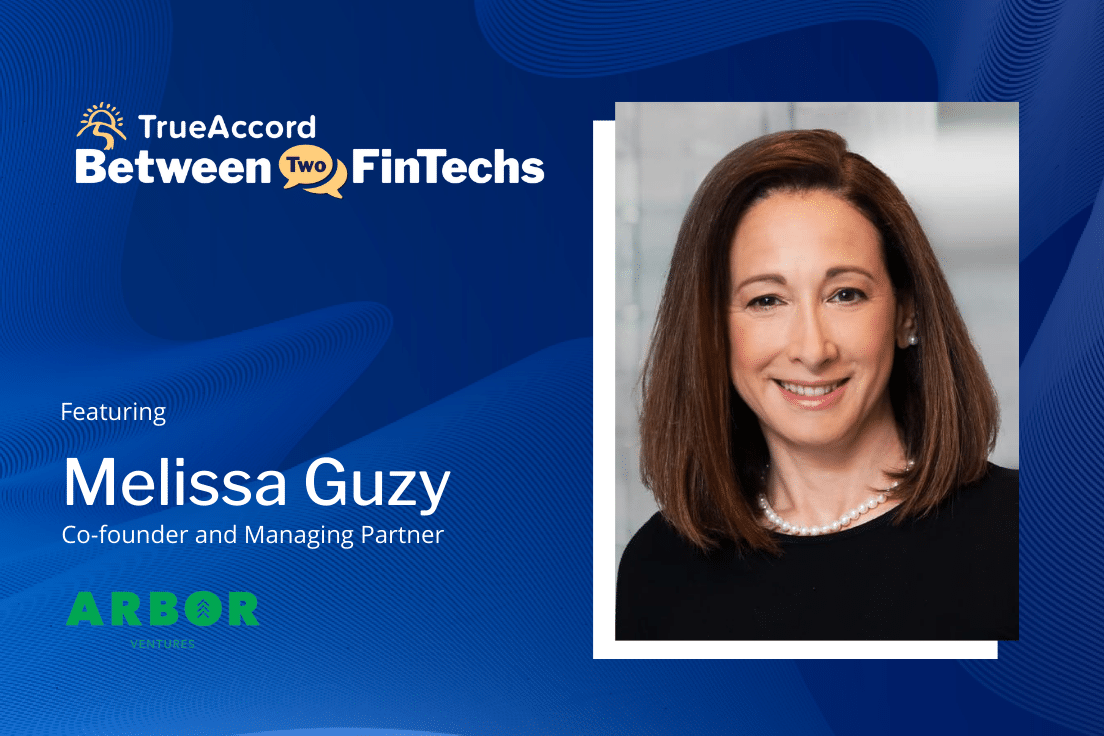
Perspectives from Melissa Guzy, Co-founder and Managing Partner of Arbor Ventures
At TrueAccord, we are motivated by how our work impacts consumer finance through technology. Given how broad the landscape is for fintech products and services, we’re excited to introduce a new speaker series on our blog, called “Between Two FinTechs: A Chat Series with FinTech Industry Leaders.” Hosted by our Founder Ohad Samet, these conversations will provide unique industry insights and a chance to highlight notable players in this space.
For our inaugural interview, we’re honored to have Melissa Guzy, Co-founder and Managing Partner of Arbor Ventures, discuss her perspectives as an investor focused on fintech companies.
This transcript was edited and condensed for clarity.
Ohad Samet: We’re really excited to be launching this new series of virtual fireside chats. The goal of these chats is for us to meet with folks from across the industry, learn about the issues they care about, and gain new perspectives on the fintech space. Today, we have Melissa Guzy, general partner at Arbor Ventures, and board member at TrueAccord. Welcome Melissa!
To start, can you tell us a little bit about yourself?
Melissa Guzy: Thank you very much for having me. It’s really an honor to do this and to chat with everyone on the team.
My story is not that unusual. I did a startup in my 20s and it was a very colorful ride, both up and down—at one point, we even went public. After that, I joined VantagePoint Venture Partners as a partner. I spent 12 years there and then decided I really wanted to do something entrepreneurial again. So in 2013, I decided to start Arbor Ventures. It was very much like doing a startup all over again. We only invest in financial services, which is something that I’m tremendously passionate about.
OS: Why the focus on financial services?
MG: I always think you’re a better investor when you’re truly personally passionate about something than just thinking, “Hey, what’s the latest fad?” An early experience has made me very passionate about debt collection in particular.
When I first started my company, I had to put expenses on my personal credit card. which is what you do when you’re completely and insanely committed to something. Eventually we received funding but it was quite stressful for a period of time.
When I think about what TrueAccord is doing, I’m quite passionate about giving people a chance to get back on track There are so many unexpected events that have happened to all of us in our lives—including now during COVID. But that doesn’t mean you’re a bad person or that you’re a bad risk. It just means at some point, you needed more flexibility than what the system was offering you.
“When I think about what TrueAccord is doing, I’m quite passionate about giving people a chance to get back on the rails.”
So when the opportunity came up to invest in TrueAccord, I said, “Absolutely.” I think Ohad probably remembers we made a decision in two days. We never looked back and we’ve been fortunate to continue to invest in the company.
OS: Thank you, and likewise we’re lucky to have you! What are some more qualities you look for in a startup that you would invest in?
MG: It’s about the people. I always say your relationship with a team or your investment lasts longer than the average marriage in the United States. When you think about investing in a company, you need to think, “I’m going to be working with this person through ups and downs for a long period of time. Is this someone I want to work with and spend my time with?”
“Your relationship with a team or your investment lasts longer than the average marriage in the United States. You need to think ‘I’m going to be working with this person through ups and downs for a long period of time. Is this someone I want to work with and spend my time with?’”
The second thing, of course, is the idea, but what we have found is that really good entrepreneurs can learn to pivot and change. Every company will go through ups and downs. So it starts with people and from there it’s about industry and sector—what gets us excited.
OS: Based on your experience, why do startups fail? Can you differentiate those who fail quickly versus those who fizzle out later?
MG: That’s a great question. Startups never fail because of one issue. Startups fail by consistently making bad calls and judgments. We’ve been studying this for quite some time and usually it has to do with not wanting to deal with the core problem at any given point in time.
You don’t want to deal with a problem or a challenge because you’re fundraising, or you don’t want to make a change on engineering because it’ll slow something down. What happens is people start to put bandaids on decisions, and then all of a sudden, the next decision is based upon something you’ve already put a bandaid on, and that just keeps building. And to me, that’s absolutely a point of failure.
I think later startups fizzle out because people forget that you’ve got to innovate and iterate every single day. We live in a very competitive world that changes at hyper speed. Often, companies will reach a threshold and then stop growing because they actually stopped innovating. And they stopped innovating because they stopped taking risks.
OS: Why do you think some fintech companies become successful versus others?
MG: The most successful startups in fintech have not been technologically revolutionary. They’ve just solved something incredibly messy. Take Stripe as an example—a couple lines of code to be able to accept credit card payments on a website so an e-commerce company didn’t have to hire a payments team. That was really simple. It wasn’t rocket science. It was messy. What they solved first was very sticky, and then they were able to build around it.
“The most successful startups in fintech have not been technologically revolutionary. They’ve just solved something incredibly messy.”
If fintech companies start with something weaker, they’re not going to be able to build around it. I think that’s one of the benefits, again, of TrueAccord. We started with something really hard and now we can add everything around it to serve the consumer in the right way.
What’s so interesting is that many financial services are consumer-centric until someone’s late on a payment, and then they don’t like that consumer anymore. They fail to realize that it’s always going to be consumer-centric. As long as we understand that everything we do, at the end of the day, is to help the consumer, we will definitely succeed massively.
OS: How do you think COVID-19 is going to change funding and the overall startup environment?
MG: I think Silicon Valley has had a hold on being the startup capital for a long time that’s well-deserved. During the 2000 downturn in venture capital, VCs on the East Coast pulled back and got scared. The venture capitalists in Silicon Valley never did, and I think that’s why the Valley has the reputation it has. It’s part of the fabric of the community to take risks and to back entrepreneurs.
I think that’s going to change as more startups and more people are moving out of cities, especially with COVID, and we’ll see much more diffusion of startups across the United States —and across the world, for that matter.
We will pull through, and we’ll be in a new norm, and there’ll be new opportunities. And you can be nothing but excited about the future.






